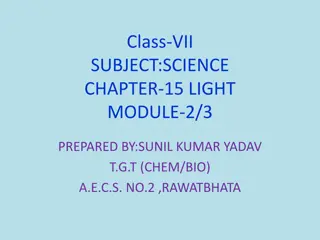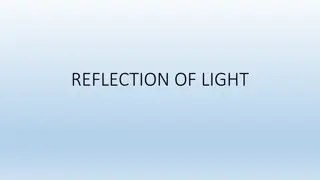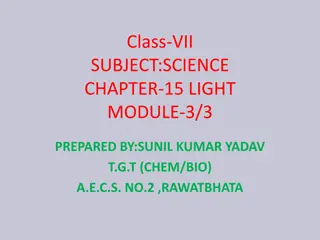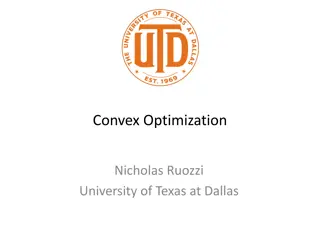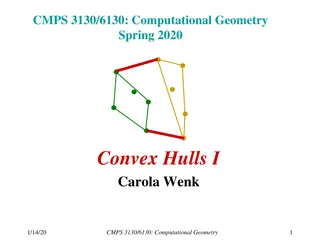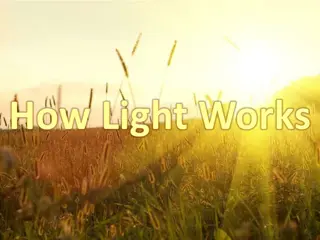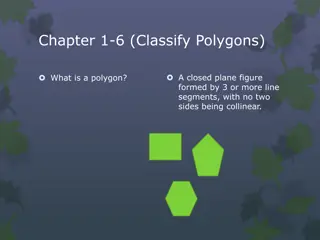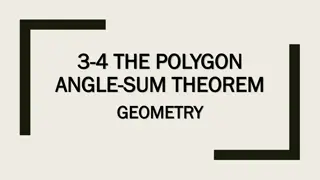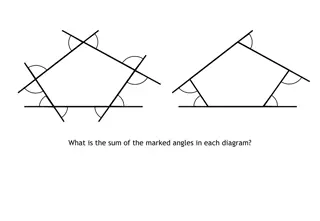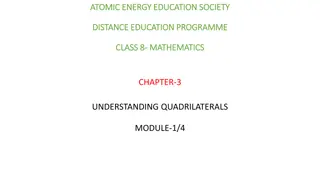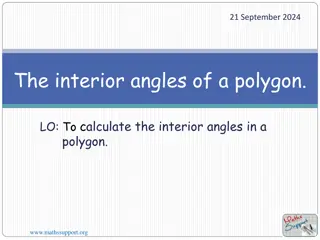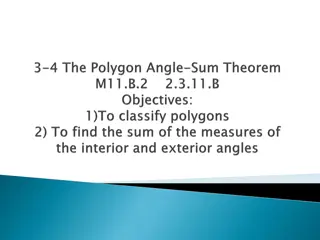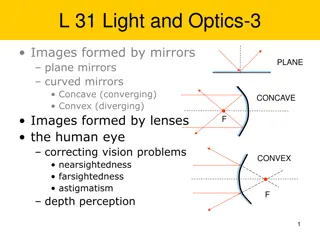Understand Convex and Concave Functions in Mathematics
Learn about convex and concave functions in mathematics, including how to differentiate between them, identify their characteristics, and analyze gradients. Explore the concepts with practical examples and visual aids. Enhance your proficiency in answering questions related to convex and concave functions effectively.
Download Presentation

Please find below an Image/Link to download the presentation.
The content on the website is provided AS IS for your information and personal use only. It may not be sold, licensed, or shared on other websites without obtaining consent from the author.If you encounter any issues during the download, it is possible that the publisher has removed the file from their server.
You are allowed to download the files provided on this website for personal or commercial use, subject to the condition that they are used lawfully. All files are the property of their respective owners.
The content on the website is provided AS IS for your information and personal use only. It may not be sold, licensed, or shared on other websites without obtaining consent from the author.
E N D
Presentation Transcript
Teachings for Exercise 9I Teachings for Exercise 9I
Differentiation You need to be able to answer questions based on concave and convex functions You might have heard of the terms convex and concave in science Convex Concave In Maths, curves can be described as concave, convex, or in some cases both! 9I
Differentiation You need to be able to answer questions based on concave and convex functions Convex function Concave function Some functions can contain both convex and concave sections A function where the line segment joining two points is above the function A function where the line segment joining two points is below the function Concave section Convex section Convex the line segment is above the curve Concave the line segment is below the curve 9I
Differentiation You need to be able to answer questions based on concave and convex functions For a convex function, the gradient is increasing Convex function The rate of change of the gradient is positive (as in, the value is increasing) A function where the line segment joining two points is above the function The rate of change of the gradient is given by the differential of the gradient function Convex the line segment is above the curve For a convex function, ?2? in the interval being considered ??2 0 for all values of x 9I
Differentiation You need to be able to answer questions based on concave and convex functions For a concave function, the gradient is decreasing Concave function The rate of change of the gradient is negative (as in, the value is decreasing) A function where the line segment joining two points is below the function The rate of change of the gradient is given by the differential of the gradient function For a convex function, ?2? in the interval being considered ??2 0 for all values of x Concave the line segment is below the curve 9I
Convex line segment is above the curve Concave line segment is below the curve Differentiation For a convex function, ?2? for all values of ? in the interval being considered For a concave function, ?2? for all values of ? in the interval being considered ??2 0 ??2 0 You need to be able to answer questions based on concave and convex functions ? ? = ?3+ 4? + 3 Differentiate with respect to ? ? ? = 3?2+ 4 Differentiate again with respect to ? ? ? = 6? Find the interval on which the function ? ? = ?3+ 4? + 3 is concave. For the function to be concave, ?2? ??2 0 6? 0 Divide by 6 ? 0 So this function is concave between any values of ?that are less than or equal to 0 9I
Convex line segment is above the curve Concave line segment is below the curve Differentiation For a convex function, ?2? for all values of ? in the interval being considered For a concave function, ?2? for all values of ? in the interval being considered ? = ?3+ 4? + 3 ??2 0 ??2 0 You need to be able to answer questions based on concave and convex functions Find the interval on which the function ? ? = ?3+ 4? + 3 is concave. ? ? ? 0 So this function is concave between any values of ? that are less than or equal to 0 Concave the line segment is below the curve 9I
Convex line segment is above the curve Concave line segment is below the curve Differentiation For a convex function, ?2? for all values of ? in the interval being considered For a concave function, ?2? for all values of ? in the interval being considered ??2 0 ??2 0 You need to be able to answer questions based on concave and convex functions ? ? = ?2?+ ?2 Differentiate with respect to ? ? ? = 2?2?+ 2? Differentiate again with respect to ? ? ? = 4?2?+ 2 Show that the function ? ? = ?2?+ ?2 is convex for all real values of ?. Now start your explanation, starting from known facts.. ?2?> 0 for all real values of x Multiply by 4 So if this function is always convex, you need to show that the second differential is always greater than 0 4?2?> 0 for all real values of x Add 2 4?2?+ 2 > 2 for all real values of x Therefore, since ? ? > 0 for all values of ?, the function will be convex for all values of ? 9I
Convex line segment is above the curve Concave line segment is below the curve Differentiation For a convex function, ?2? for all values of ? in the interval being considered For a concave function, ?2? for all values of ? in the interval being considered ??2 0 ??2 0 ? = ?2?+ ?2 You need to be able to answer questions based on concave and convex functions Concave the line segment is above the curve Show that the function ? ? = ?2?+ ?2 is convex for all real values of ?. So if this function is always convex, you need to show that the second differential is always greater than 0 9I
Convex line segment is above the curve Concave line segment is below the curve Differentiation For a convex function, ?2? for all values of ? in the interval being considered For a concave function, ?2? for all values of ? in the interval being considered ??2 0 ??2 0 As we move along this curve, it changes from concave to convex You need to be able to answer questions based on concave and convex functions There must be an exact point where this change happens The point at which a curve changes from being concave to convex is known as a point of inflection. This is known as a point of inflection ? = ?(?) At a point of inflection, the curve changes from concave to convex Therefore, the sign of the second differential must change 9I
Convex line segment is above the curve Point of inflection position where the second differential changes sign Concave line segment is below the curve Differentiation For a convex function, ?2? for all values of ? in the interval being considered For a concave function, ?2? for all values of ? in the interval being considered ??2 0 ??2 0 You need to be able to answer questions based on concave and convex functions ? = ?3 2?2 4? + 5 Differentiate with respect to ? ?? ??= 3?2 4? 4 Differentiate again with respect to ? The curve ? has equation ? = ?3 2?2 4? + 5 ?2? ??2= 6? 4 Now you should consider the first interval given a) Show that C is concave on the interval 2,0 and convex on the interval 1,3 6? 4 If ? = 2 If ? = 0 = 4 = 16 Since the function is linear, ?2? ??2 0 for all 2 ? 0 b) Find the coordinates of the point of inflection 9I
Convex line segment is above the curve Point of inflection position where the second differential changes sign Concave line segment is below the curve Differentiation For a convex function, ?2? for all values of ? in the interval being considered For a concave function, ?2? for all values of ? in the interval being considered ??2 0 ??2 0 You need to be able to answer questions based on concave and convex functions ? = ?3 2?2 4? + 5 Differentiate with respect to ? ?? ??= 3?2 4? 4 Differentiate again with respect to ? The curve ? has equation ? = ?3 2?2 4? + 5 ?2? ??2= 6? 4 Now you should consider the second interval given a) Show that C is concave on the interval 2,0 and convex on the interval 1,3 6? 4 If ? = 1 If ? = 3 = 14 = 2 Since the function is linear, ?2? ??2 0 for all 1 ? 3 b) Find the coordinates of the point of inflection 9I
Convex line segment is above the curve Point of inflection position where the second differential changes sign Concave line segment is below the curve Differentiation For a convex function, ?2? for all values of ? in the interval being considered For a concave function, ?2? for all values of ? in the interval being considered ??2 0 ??2 0 You need to be able to answer questions based on concave and convex functions ? = ?3 2?2 4? + 5 Differentiate with respect to ? ?? ??= 3?2 4? 4 Differentiate again with respect to ? The curve ? has equation ? = ?3 2?2 4? + 5 ?2? ??2= 6? 4 To find the coordinates of the point of inflection, set the second differential equal to 0 (since this point is where the sign of the second differential changes, it make sense that the point itself must give a value of 0) a) Show that C is concave on the interval 2,0 and convex on the interval 1,3 6? 4 = 0 Add 4 b) Find the coordinates of the point of inflection 2 3,47 6? = 4 Divide by 6 ? =2 3 Use the original equation to find the value of ? 27 ? =47 27 9I
Convex line segment is above the curve Point of inflection position where the second differential changes sign Concave line segment is below the curve Differentiation For a convex function, ?2? for all values of ? in the interval being considered For a concave function, ?2? for all values of ? in the interval being considered ??2 0 ??2 0 You should verify that ?2? You need to be able to answer questions based on concave and convex functions ??2 changes sign across the point we found Choose values of ? either side of 2 3 and substitute them in The curve ? has equation ? = ?3 2?2 4? + 5 ?2? ??2= 6? 4 a) Show that C is concave on the interval 2,0 and convex on the interval 1,3 If ? =2 If ? = 0.6 If ? = 0.7 3 ?2? ??2= 0.4 ?2? ??2= 0 ?2? ??2= 0.2 b) Find the coordinates of the point of inflection 2 3,47 Change of sign 27 9I
Convex line segment is above the curve Point of inflection position where the second differential changes sign Concave line segment is below the curve Differentiation For a convex function, ?2? for all values of ? in the interval being considered For a concave function, ?2? for all values of ? in the interval being considered ??2 0 ??2 0 ? = ?3 2?2 4? + 5 You need to be able to answer questions based on concave and convex functions The curve ? has equation ? = ?3 2?2 4? + 5 2 3,47 27 a) Show that C is concave on the interval 2,0 and convex on the interval 1,3 b) Find the coordinates of the point of inflection 2 3,47 27 Note that a point of inflection is not necessarily a stationary point! 9I


